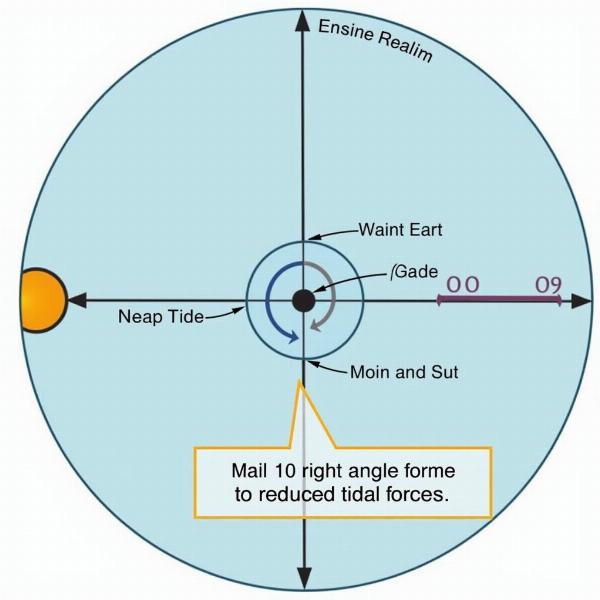Neap tides, a fascinating natural phenomenon, refer to periods of moderately low high tides and moderately high low tides. Understanding their meaning in Hindi, along with their underlying causes, provides valuable insights into the rhythmic dance between the Earth, the Moon, and the Sun. This article aims to delve into the “neap tide meaning in Hindi,” exploring its various aspects and significance.
What Does Neap Tide Mean in Hindi?
Neap tide is commonly referred to as “कृष्णपक्ष ज्वार” (Krishnapaksha Jwar) or “लघु ज्वार” (Laghu Jwar) in Hindi. “Krishnapaksha” refers to the waning phase of the moon, while “Laghu” means small or low. Thus, these terms highlight the reduced tidal range characteristic of neap tides. While the literal translation might not fully capture the scientific nuances, it effectively conveys the essence of lower tidal variations.
 Neap Tide Diagram
Neap Tide Diagram
Understanding the distinction between neap tides and their counterpart, spring tides (“शुक्लपक्ष ज्वार” – Shuklapaksha Jwar or “बृहत् ज्वार” – Brihat Jwar), is crucial. Spring tides occur during full and new moons, exhibiting significantly higher high tides and lower low tides. tide meaning in hindi and english will give you a more detailed explanation of tides in general.
The Science Behind Neap Tides
Neap tides occur when the Sun and Moon are at right angles to each other relative to the Earth. This alignment happens during the first and third quarter moon phases. During these phases, the gravitational forces of the Sun and Moon partially cancel each other out, resulting in a smaller overall tidal bulge.
Why are Neap Tides Weaker?
The gravitational pull of the Sun, though weaker than the Moon’s influence on tides, plays a significant role in modulating tidal ranges. When the Sun and Moon are aligned (during spring tides), their combined gravitational forces create larger tidal bulges. Conversely, during neap tides, the opposing pull weakens the overall tidal effect, leading to smaller variations between high and low tides.
The Impact of Neap Tides
Neap tides have a significant impact on coastal ecosystems and human activities. They influence navigation, fishing, and coastal erosion. Understanding neap tide patterns is crucial for safe and efficient maritime operations.
Neap Tides and Coastal Life
Many coastal organisms synchronize their life cycles with tidal rhythms. Neap tides, with their reduced water movement, can impact the distribution of nutrients and organisms in intertidal zones.
How to Predict Neap Tides
Predicting neap tides is relatively straightforward. They occur approximately a week after spring tides, coinciding with the first and third quarter moon phases. Tide tables and online resources readily provide information on predicted neap tide timings for specific locations.
Conclusion
Neap tides, known as “कृष्णपक्ष ज्वार” or “लघु ज्वार” in Hindi, represent periods of reduced tidal variations. Understanding these tides is vital for various coastal activities. The interplay of gravitational forces between the Sun, Moon, and Earth dictates the occurrence and intensity of neap tides. By grasping the science behind these tidal phenomena, we can better appreciate the dynamic nature of our oceans and coastlines. high tides meaning in hindi will help you understand the other side of the tidal spectrum.
FAQ
- What is the opposite of a neap tide? A spring tide is the opposite of a neap tide, characterized by larger tidal ranges.
- When do neap tides occur? Neap tides occur during the first and third quarter moon phases.
- Why are neap tides important? Neap tides influence coastal ecosystems, navigation, and various human activities.
- How can I find out when the next neap tide will be? Tide tables and online resources provide neap tide predictions for specific locations.
- What is the difference between “कृष्णपक्ष ज्वार” and “लघु ज्वार”? Both terms refer to neap tides, highlighting the waning moon phase and reduced tidal range.
- Do neap tides affect all coastal areas equally? The impact of neap tides varies depending on local geography and other factors.
- How does the Sun influence neap tides? The Sun’s gravitational pull partially counteracts the Moon’s pull during neap tides, leading to smaller tidal variations.
Meaning-Hindi.in is your trusted partner for high-quality Hindi translation services. We offer expertise in various domains, including business, legal, technical, website localization, and educational translations. Whether you need quick turnaround times or specialized industry knowledge, our team is here to help. Contact us at [email protected] or +91 11-4502-7584 to discuss your translation needs. Let Meaning-Hindi.in bridge the language gap for you!